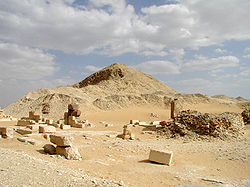
Neith (wife of Pepi II)
Encyclopedia
- For the Egyptian goddess of the same name see NeithNeithIn Egyptian mythology, Neith was an early goddess in the Egyptian pantheon. She was the patron deity of Sais, where her cult was centered in the Western Nile Delta of Egypt and attested as early as the First Dynasty...
.
Neith was an ancient Egypt
Ancient Egypt
Ancient Egypt was an ancient civilization of Northeastern Africa, concentrated along the lower reaches of the Nile River in what is now the modern country of Egypt. Egyptian civilization coalesced around 3150 BC with the political unification of Upper and Lower Egypt under the first pharaoh...
ian queen consort, one of the principal queens of the Old Kingdom
Old Kingdom
Old Kingdom is the name given to the period in the 3rd millennium BC when Egypt attained its first continuous peak of civilization in complexity and achievement – the first of three so-called "Kingdom" periods, which mark the high points of civilization in the lower Nile Valley .The term itself was...
pharaoh Pepi II, who ruled (c. 2278 BC–c. 2184 BC). Queen Neith was named after goddess Neith
Neith
In Egyptian mythology, Neith was an early goddess in the Egyptian pantheon. She was the patron deity of Sais, where her cult was centered in the Western Nile Delta of Egypt and attested as early as the First Dynasty...
.
Family
Neith is thought to have been a daughter of the pharaoh Pepi I and queen Ankhesenpepi IAnkhesenpepi I
Ankhenespepi I or Ankhenesmeryre I was a queen consort during the sixth dynasty of Egypt.- Biography :Ankhesenpepi was a daughter of Nebet the female vizier and her husband Khui...
, making her half-sister and cousin to pharaoh Pepi II. Neith may be the mother of King Nemtyemsaf II. There is a legend about Queen Nitocris
Nitocris
Nitocris has been claimed to have been the last pharaoh of the Sixth Dynasty. Her name is found in the Histories of Herodotus and writings of Manetho but her historicity is questionable. She might have been an interregnum queen...
who, if she indeed existed at all, may have been a daughter of Neith.
Titles
Her titles as a royal daughter include: King’s Daughter (s3t-niswt), Eldest King’s Daughter of his body (s3t-niswt-smswt-n-kht.f), Eldest King’s Daughter of his body of Mennefer-Meryre (s3t-niswt-smswt-n-kht.f-mn-nfr-mry-r’), and Hereditary Princess (iryt-p`t),As a wife of the pharaoh she used the titles: King’s Wife (hmt-nisw), Beloved King’s Wife of Men-ankh-Neferkare (hmt-nisw meryt.f-mn-‘nkh-nfr-k3-r’), Great of Praises (wrt-hzwt), Great one of the hetes-sceptre (wrt-hetes), She who sees Horus and Seth (m33t-hrw-stsh), Attendant of Horus (kht-hrw), Consort and beloved of the Two Ladies (sm3yt-mry-nbty), Companion of Horus (tist-hrw), and Companion of Horus (smrt-hrw)
Neith's title King’s Mother (mwt-niswt) shows that she was the mother of a pharaoh.
Burial

Neith's pyramid may have been the first one constructed among the queen's pyramids associated with Pepi II. Neith's pyramid complex included a small temple, a satellite pyramid and a fleet of sixteen wooden boats buried between the main and satellite pyramid. The entrance to the enclosure was flanked by two inscribed obelisks. Neith's burial chamber and was inscribed with pyramid texts. This is the first known occurrence of these texts in a queen's pyramid. The burial chamber contained a red granite sarcophagus (empty) and a canopic chest.
The remains of at least part of her mummy were uncovered and were once housed in the Qasr el-Aini Medical School.

